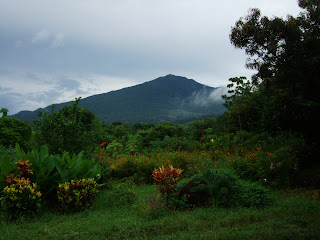It is always fun to have a birthday when you are a kid. Our birthdays were lots of fun this year because we were in Nicaragua.
We’d like to tell you about our birthdays (cumpleaños) in Nicaragua.
Something that was different about our birthdays here was we bought a piñata at the market. At the market there is a section that is probably 100 metres long, and there are piñatas for sale on both sides. We saw some as tall as Danielle. We choose a colourful star piñata because it suits both boys and girls.
Another difference is that we had one birthday party at the Hernandez’s house. We normally have two separate parties with our friends.
A big difference was that we knew two or three of the presents we would receive because we were shopping with our mom and dad when they bought them.
There were very few things similar to our birthdays at home. We had cake! We had breakfast in bed and opened our presents. Normally we would have cupcakes for breakfast but this time we had Oreo cookies.
We had four parties. One party was on Danielle’s birthday. It was at dinner time with some people from the Hernandez family (Mrs. Hernandez, Judith and Nathan). Mrs. Hernandez made hamburgers and french fries. My mom made a vanilla cake with chocolate icing and sprinkles for dessert. Simon’s party was at Tesoros de Dios with lots of kids on his birthday. Someone else had a birthday party on the same day. His name is Lot. They had a very big cake, and there were treats and toys in cups for everyone. Mom made two small chocolate cakes at the centre and we shared them with almost everyone.

Simon sharing his birthday at Tesoros de Dios
We had an “in between” party with a piñata on the day between our birthdays. Mr. and Mrs. VanderWees, and Jesse and KeKe, and Michele, and Judith came to our party. Mom made brownies.

Danielle is wearing her new Nicaragua dress and jumping to hit the pinata.
We also had a very early birthday party at Oma and Opa’s cottage in July.
These are some of the presents and surprises that we received for our birthday.
Danielle: For my birthday I got a very nice white Nicaraguan dress. It has embroidery on it of a lady, a drum and two xylophones. They usually wear this dress to do a special dance in Nicaragua. Simon gave me a wooden box that is shaped like a horse. It can come apart like a puzzle and has a secret drawer in the middle. I got a notepad for watercolours and a set of watercolours.
This is a picture of Danielle painting a vase of flowers with her new paints.
We both got hammocks for our birthdays. We picked the colours and ordered them at a special place in Granada. Danielle’s is pink, blue and white. Simon’s is white and blue like the colours of the Nicaragua flag.
Simon: For my birthday I got four presents. My parents gave me a wooden spin top with a string. It has very nice colours. I am still learning how to make it spin properly. One time we saw a man who was able to spin it on my hand, my back and his tongue! I also got a Nicaragua soccer shirt. I like it. It is blue and white like my hammock. Danielle gave me a Rubix cube, which I have always found very hard. Like Danielle, I got some drawing paper and I got pastels.
We got a GameBoy connector cable to share. We have played a game called Mario Cart Super Circuit because it is the only game that we have that is for two players.
Grandma says there will be something in Australia for our birthdays.
On Simon’s birthday we visited a Christian ministry that is teaching people to be blacksmiths. We saw someone making a leaf from a metal rod, and we each got to keep one. It was a very, very hot place to be.

This person is working on the leaf.
Simon says, “For my birthday next year I am looking forward to a sleepover with my best friends.”
Danielle says, “For my birthday next year I would like to have an “Around the World” party.





 Pretty groovy boots and sports socks, eh?
Pretty groovy boots and sports socks, eh? 































 Clouds wrapped around the top of Volcan Concepcion.
Clouds wrapped around the top of Volcan Concepcion. 










